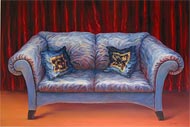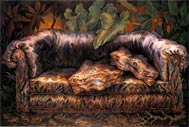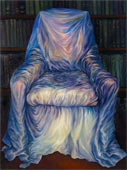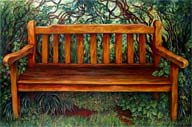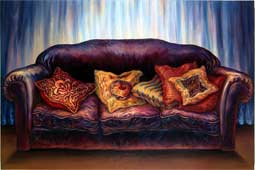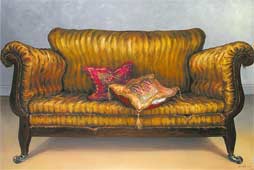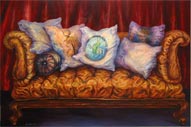|
COUCH
It all happens on the couch. From conception to death many of life’s defining moments occur between upholstered arms.
The body may be in repose while cerebral functions are working overtime .... or not.
Reclining on the couch enjoying precious moments of peace and solitude, secure from stress and tribulation, our minds are free to wander and imagine as we read, watch T V, or just dream.
Here, also, much social interaction takes place, whether intellectual discourse, or merely the exchange of trivial gossip that bonds family, lovers and friends. Minds meet to debate world affairs, hatch plots, manipulate and deceive. A couch can also provide a stage for more dramatic incidents of love, passion, violent disagreement, even murder.
There is an expectation when approaching a piece of furniture, especially a soft couch, that it will provide protection and support for the body . However, this may prove false when the inhabitant of the couch is cowering prostrate in pain, ill, lonely or afraid. We choose not to linger on the neutral surfaces of seats in waiting rooms at dentists, hospitals or railway stations and shun the over -stuffed menacing satin of a grand museum piece, only to sink with weary gratitude onto a rough wooden bench, revelling in the luxury of being raised off the cold, damp ground.
Couches, sofas, settees, chairs have many guises. Not only do these objects of repose provide security and comfort in an uncertain world, they can also illustrate a sense of style or cultural heritage and advertise status in the community.
A vacated couch or chair can retain traces of the physical characteristics and even the personality of an habitual occupant and so the banality of these commonplace objects with which we share our lives may be transformed and made beautiful.
Sylvia Siddell 2005
|
|
|
|
REVIEWS OF COUCH
THE NATIONAL BUSINESS REVIEW
17-Feb-2005
SYLVIA SIDDELL TAKES HER SEAT IN HISTORY
Couches and chairs or furniture generally does not figure much in the history of art over the past 500 years. There were, however, always a few big thrones used usually as desirable places for God and the Virgin Mary to sit on.
They were also useful props for important people when they had their portraits painted. Rarely was the furniture painted for itself, apart from a few by Van Gogh and a few versions by the Cubists.
Auckland artist Sylvia Siddell has previously given humble household items such as stoves and vacuum cleaners a degree of status avoided by most artists. Now she has done that for the humble chair and couch with her latest exhibition Couch, a set of 11 paintings.
Each chair has become animated, provided with a secret life or personality. The artist notes in her statement to the show that "Couches, sofas, settees, chairs have many guises. Not only do these objects of repose provide security and comfort in an uncertain world, they can also illustrate a sense of style or cultural heritage and advertise status in the community."
The couches range from the formal and tidy to bedraggled and they all speak about owners, events and moods.
Blue Settee is one of the few well upholstered prim and conventional couches but next to it is the Feral Couch , set amid a jungle of leaves and branches with its cushion zips bared like teeth.
Office Chair looks like one of her works from several years ago, with its frenetic construction, as though it has been mauled by the Feral Couch. Library Chair is a ghost-like work with the chair covered in a white sheet. The background setting of a wall of leatherbound tomes creates a sensation of silence and emptiness.
With some of the couches the decorative cushions provide a narrative, as with Historic Couch where there is a complex group of cushions whose images deal with sexuality; paleolithic fertility symbols, Medusa, an Egyptian fertility goddess and a contemporary Japanese punk diva.
In Adam & Eve, one cushion has an embroidered image of Durer's Adam and Eve and another of the archangel with a blazing sword. In this painting the chair has collapsed and the wheels on the end of the short feet have collapsed as though Paradise itself has fallen apart.
The set of paintings also provides a brief design history of furniture from the classical Regency style of Adam and Eve and Victorian Blue Settee through to the 1970s Danish Red Chair and the prosaic Garden Seat .
There is also a brief acknowledgment of New Zealand design with Kauri Chair carved with a koru design and a small ruru.
John Daly-Peoples
THE NEW ZEALAND HERALD
16 Feb 2005
The long-established painter Sylvia Siddell is at Artis Gallery until March 6. She manipulates paint to give a wriggling life to everyday objects. Her work has consistently got bigger and more confident. This year, full-sized couches and garden seats get the treatment in this lively show.
It is at its most quirky and effective when details give a surreal spin to the image. Notable is Feral Couch, where vegetation threatens the human world and the couch cushions have teeth.
Strangest is a draped Library Chair, which takes on a ghostly Miss Haversham quality. The white drapery gives it more force of suggestion than the various femmes fatale of Historic Couch, delightful though that work is.
T.J. MacNamara
|
|
|
